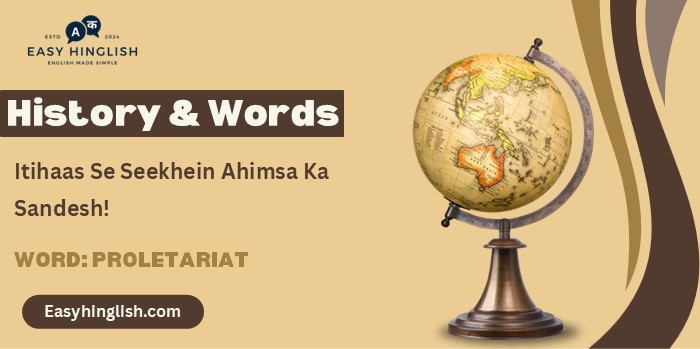History & Words: ‘Proletariat’ (1 May)
Welcome to ‘History & Words’! 🌟 Main hoon Prashant, Wordpandit aur Learning Inc. Network ka founder. Yeh series language learning aur historical context ko connect karti hai, taaki vocabulary improve ho aur history ki understanding bhi deep ho.
Chaliye, shabdon ki iss journey par mere saath chaliye aur naye naye words explore karte hain! 😊
📚 Table of Contents
🔍 Word of the Day: Proletariat
Pronunciation: /prəʊlɪˈtɛːrɪət/ (pro-li-TAIR-ee-uht)
Definition: The class of wage-earning workers in a capitalist society who do not own production means and must sell their labor to survive—often referred to as the working class.
🌍 Parichay (Introduction)
1 May 1886 ko Chicago me aisa kuch hua jo duniya bhar ke mazdooron ke liye International Workers’ Day (May Day) ka foundation ban gaya.
Thousands of working-class laborers, yaani the proletariat, ne streets par march kiya, demanding something radical yet fair: an 8-hour workday.
Yeh protests aage chalkar Haymarket Affair ban gaye—aur “proletariat” ek political aur historical identity ka pratinidhitva ban gaya.
🌱 Shabd ka Utpatti (Etymology)
Proletariat aaya hai Latin word “proletarius” se:
- “Proles” – arth: “offspring”
- Roman usage me: wo log jinke paas wealth nahi thi—sirf unke bachche (future soldiers/workers) unka productive asset the
Toh Proletariat ka literal arth hai: “those who produce offspring”—lekin modern usage me iska matlab hai working class without property or power.
Yeh term Marxist theory ke through globally popular hua, especially 19th–20th century me.
📖 Mahatvapurn Shabdavali (Key Vocabulary)
- 🔑 Working Class: Wage laborers jo physical ya low-paid jobs karte hain
- 🔑 Bourgeoisie: Capitalist class jo production ke means ka malik hota hai
- 🔑 Class Struggle: Marxist theory ke anusaar society me ongoing conflict between the proletariat and bourgeoisie
- 🔑 Labor Union: Workers ka collective group jo apne rights ke liye negotiate karta hai
- 🔑 Alienation: Condition jisme workers apne kaam aur creativity se alag ho jaate hain
- 🔑 May Day: Global celebration of labor solidarity, rooted in the sacrifices of 1886
🏛️ Itihasik Sandarbh (Historical Context)
1880s ke US me workers 10–16 ghante kaam karte the—low wages, no rights, and unsafe conditions.
1 May 1886:
- 400,000+ American workers ne nationwide strike call ki
- Chicago me mass demonstrations hua
- 4 May ko Haymarket Square me police aur protestors ke beech violent clash hua—jise Haymarket Affair kehte hain
- Multiple deaths and arrests hue, par ek nayi global awakening bhi hui:
“Workers of the world must unite.”
Is uprising ne proletariat identity ko global labor consciousness ke center me rakh diya.
⏳ Samayrekha (Timeline)
- 1848: Karl Marx aur Friedrich Engels The Communist Manifesto publish karte hain
- 1 May 1886: Labor strikes across the U.S., Chicago becomes epicenter
- 4 May 1886: Haymarket Affair triggers global labor solidarity
- 1889: Second International May Day ko international labor holiday declare karta hai
- 20th Century: USSR, Cuba, China, aur social democracies me proletariat symbol of strength ban jata hai
- Present Day: May Day globally labor rights, fair wages, and social justice ka day ban gaya hai
🌟 Is Din ka Mahatva (The Day’s Significance)
1 May ek worker-led revolution ka memorial hai:
- ✅ Isne modern employment contracts aur 8-hour workday ko legal ground diya
- ✅ “Proletariat” ek oppressed identity se revolutionary class me transform ho gaya
- ✅ Haymarket Affair ne labor law, political reform aur leftist movements ko global platform diya
Yeh din hume yaad dilata hai: Rights maange nahi jaate—organize karke liye jaate hain.
💬 Prasiddh Ukti (Quote)
“Let the ruling classes tremble at a Communistic revolution. The proletarians have nothing to lose but their chains. They have a world to win.”
— Karl Marx, The Communist Manifesto (1848)
(Matlab: Mazdoor ke paas khona kuch nahi hota—sirf jodne aur jeetne ka ek vishwa hota hai.)
🔮 Aaj Ka Matlab aur Chintan (Modern Usage & Reflection)
Aaj Proletariat ek historical term hone ke sath-saath living reality bhi hai:
- ✅ Gig workers, factory laborers, delivery agents—yeh sab nayi century ke proletariat hain
- ✅ Labor rights, minimum wage laws, union protections—sab is class ki demands ka result hain
- ✅ Post-COVID world me “essential workers” phrase ne phir se proletariat ko spotlight me la diya
Yeh term hume sikhata hai: Progress tabhi hota hai jab har haath kaam kare aur har awaz suni jaaye.
🏛️ Virast (Legacy)
- ✅ Proletariat ne modern labor laws, weekends, aur workplace protections ko force kiya
- ✅ Marxism, socialism, aur trade unionism sab is class ke naam par build hue
- ✅ May Day ek global labor solidarity ka flagship moment ban gaya
- ✅ Aaj bhi proletariat ek symbol of collective resilience hai—be it streets or servers
🔍 Tulnatmak Vishleshan (Comparative Analysis)
Pehle: Proletariat ko “lower class” ya “unskilled” mana jaata tha
Baad me: Political theories ne inhe history ka engine banaya
Aaj: Digital era ka working class bhi invisible backbone ban gaya hai—par fight ab bhi wahi hai
Yeh evolution dikhata hai ki class change hoti hai, par struggle usi se shuru hoti hai.
💡 Kya Aapko Pata Hai? (Did You Know?)
🎓 Antim Vichar (Conclusion)
‘Proletariat’ ek aisa shabd hai jo sirf class describe nahi karta—it defines movement, history, and resistance.
1 May 1886 ko Chicago ki sadkon par jinhone awaz uthayi, unhone ek global language establish ki—justice through solidarity.
Aaj bhi jab kabhi worker’s voice dabayi jaati hai, “proletariat” ek echo ban kar laut aata hai—reminding us that labor builds nations, and dignity must never be optional.
📚 Aage Padhne Ke Liye (Further Reading)
- 📖 The Communist Manifesto – Karl Marx & Friedrich Engels
- 📖 Haymarket: A History – Martin Duberman
- 📖 Labor’s Untold Story – Richard O. Boyer & Herbert M. Morais
- 📖 Workers of the World: Essays Toward a Global Labor History – Marcel van der Linden
- 📖 The Condition of the Working Class in England – Friedrich Engels








